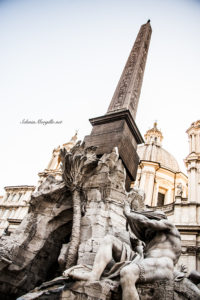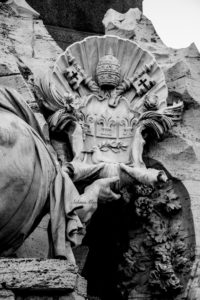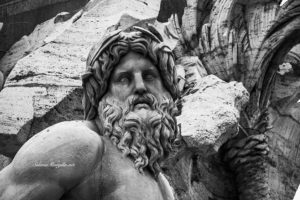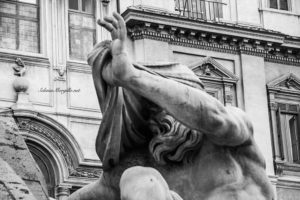Navona Square, the Fountain of the Four Rivers by Bernini
Italian Version Below*
The eye is lost in wonder and you have to return several times to dream about it.
When on June 12, 1651, the Fountain of the Four Rivers was inaugurated in the romantic and unique setting of Piazza Navona in the world, the fame of its author Gian Lorenzo Bernini grew further in Rome and Europe.
Those were the years of the pontificate of Innocent X Pamphilj (1644-1655). The pontiff had clearly expressed his predilection for Francesco Borromini, Bernini’s enemy who was still too attached to the hated Barberini.
Not surprisingly, at first, the project for the entire “renovation” of Piazza Navona had been entrusted to Borromini, but when the clever Bernini gave Olimpia Maidalchini (the Pimpaccia of Rome and Pope’s sister-in-law) and to the Pope a model of the future “Fountain of the 4 Rivers” the scenario changed.
The Berninian project was approved and in 1649 the gigantic travertine block (from the Tivoli quarries) was placed on the foundations.
Work began and the fountain “came to life” in a very short time, with the magnificent statues of the Quattro Fiumi (Nile, Ganges, Danube, Rio de la Plata – Four Rivers) made by Jacopoantonio Fancelli, Claude Poussin, Antonio Raggi, and Francesco Baratta.
Bernini claimed the authorship of the horse and the creation of the incredible flora and fauna that surrounds the entire fountain.
At the center of this magnificent composition stands the so-called Agonal Obelisk which in the past lay near the Mausoleum of Cecilia Metella / Circus of Maxentius along the Via Appia.
It was transported to Piazza Navona and crowned with a bronze cast dove.
The dove with the olive branch in its mouth is a symbol of the Holy Spirit and peace after the universal flood, as well as the main element of the Pamphilj family’s emblem.
InfoSite: Navona Square on GoogleMaps
All rights reserved*
L’occhio vi si perde per meraviglia e bisogna ritornare più volte per vagheggiarla.
Quando il 12 Giugno del 1651 fu inaugurata, la Fontana dei Quattro Fiumi nello scenario romantico ed unico al mondo di Piazza Navona, la fama del suo autore Gian Lorenzo Bernini, crebbe ulteriormente a Roma ed in Europa.
Erano gli anni del pontificato di Innocenzo X Pamphilj (1644-1655). Il pontefice aveva chiaramente espresso la sua predilezione per Francesco Borromini, nemico di Bernini che risultava ancora troppo legato agli odiati Barberini.
Non a caso, in un primo momento, il progetto dell’intera “ristrutturazione” di Piazza Navona era stato affidato a Borromini, ma quando il furbo Bernini regalò ad Olimpia Maidalchini (la Pimpaccia di Roma e cognata del Papa) ed al Pontefice un modello della futura “Fontana dei 4 Fiumi” lo scenario cambiò.
Il progetto berniniano fu approvato e nel 1649 fu sistemato sulle fondamenta il gigantesco blocco di travertino (provenienti dalle cave di Tivoli). Iniziarono i lavori e la fontana “prese vita” in tempi rapidissimi, con le magnifiche statue dei Quattro Fiumi (Nilo, Gange, Danubio, Rio de la Plata) realizzate da Jacopoantonio Fancelli, Claude Poussin, Antonio Raggi e Francesco Baratta.
Bernini rivendicò la paternità del cavallo e la realizzazione dell’incredibile flora e fauna che avvolge l’intera fontana.
Al centro di questa magnifica composizione svetta il cosiddetto Obelisco Agonale che in passato giaceva nei pressi del Mausoleo di Cecilia Metella/Circo di Massenzio lungo la via Appia.
Fu trasportato in Piazza Navona e coronato con una colomba fusa in bronzo.
La colomba con il ramoscello d’ulivo in bocca è simbolo dello Spirito Santo e della pace dopo il diluvio universale, nonché elemento principale dello stemma identificativo della famiglia Pamphilj.
Info Site: Piazza Navona
Sostieni la #culturachevince, aiuta la condivisione.



